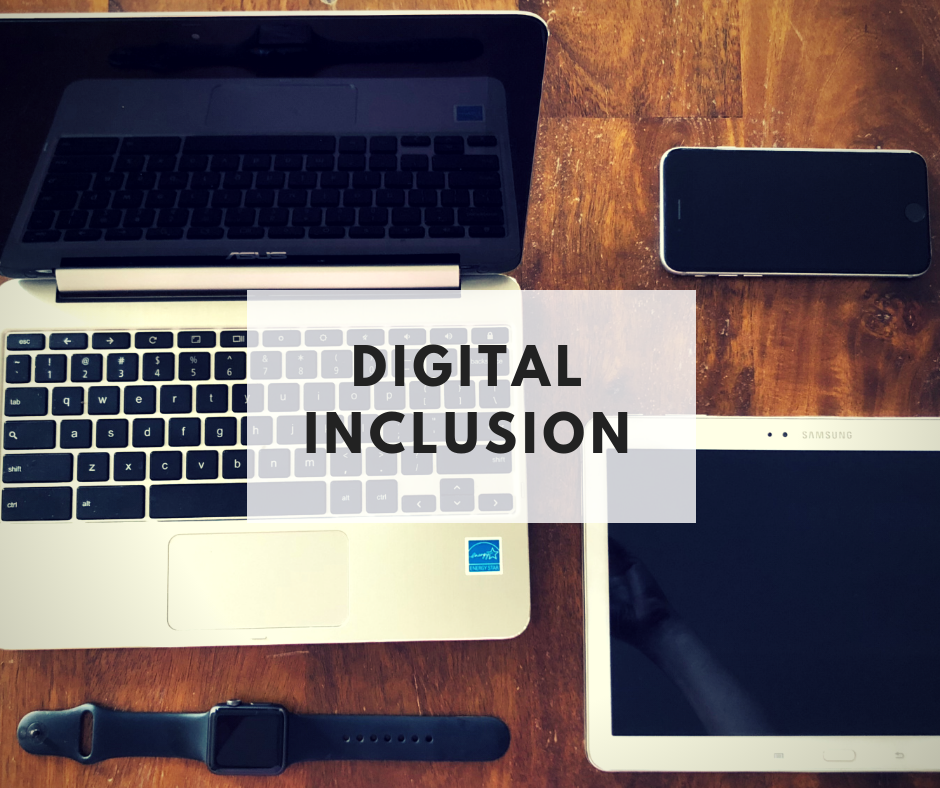For the past several months, we’ve been working on a Digital Inclusion Design Challenge. As defined by the National Digital Inclusion Alliance, digital equity exists when “all individuals and communities have the information technology capacity needed for full participation in our society, democracy, and economy.” With estimates of global internet use at only 55%, many countries have a long way to go to achieve digital equity.
Even in the U.S. where the Pew Research Center estimates that 89% of adults use the internet, not all benefit equally. As shown in the slides below, internet usage varies based on a variety of demographic factors, including age (e.g., 66% for adults age 65+), income (e.g., 81% for those earning less than $30,000 per year), educational attainment (e.g., 65% for those without a high-school diploma), and community type (e.g., 78% for those living in rural communities).
Also, the Pew Research Center data suggest the reliance on traditional home broadband for internet access has decreased while smartphone usage has increased. Increasingly, smartphones are the primary means of home online access for many adults. Based on 2018 data, 25% of adults are currently “smartphone-only” internet users, which means their primary means of accessing the internet is via a smartphone. However, smartphone-only internet dependency varies based on various demographics, including race (e.g., 35% for Hispanic population), income (e.g., 31% for those earning less than $30,000 per year), educational attainment (e.g., 39% for those without a high-school diploma), and age (e.g., 29% for age 18-29). As designers, we must think about what this increasing reliance on smartphone access over traditional home broadband means for how our future learners might access the internet and the learning experiences we are designing.
Another important consideration for designers is that digital access does not equate to digital literacy. A recent large-scale international study of adult competencies revealed a staggering 64% of US adults performed at or below the lowest proficiency levels in problem-solving in technology-rich environments. While most adults have access to smartphones, millions lack the digital skills needed to communicate, acquire and evaluate information, and perform practical tasks using technology. With recent studies from Burning Glass Technologies suggesting over 80% of middle-skill jobs in the United States requiring digital skills, the digital literacy skills gap is a massive barrier to not only accessing vital services but also achieving self-sufficiency.
As designers, our ultimate aim is to help learners overcome barriers and find opportunities through the attainment of new skills and knowledge. The digital inequity described above is screaming for our field’s attention to help foster digital inclusion.
The Building Digital Communities Framework notes digital inclusion is influenced by the extent to which digital (a) access, (b) adoption, and (c) application are effectively supported within a community. The following summarizes these aspects of digital inclusion as defined with the framework. Note that we (as designers) can plan a role in all three of these areas (e.g., designing for inclusion, digital literacy training, education, economic and workforce development, etc.)
As outlined in the openly licensed framework guide, the following reprints the definitions of access, adoption, and application:
Access
- Availability: A reliable communications infrastructure is the raw material for innovation, growth, and competitive engagement in today’s information-based world.
- Affordability: Access to the Internet needs to be affordable for communities and their members to benefit from the expanded opportunities of digital life.
- Design for Inclusion: People with disabilities, physical or cognitive differences, and differences in age-related capabilities, language, literacy or culture may face challenges using technology and participating in digital life.
Adoption
- Public Access: Public access to technology is necessary for community members who have little or no communication technology available in the home, need assistance to use technology effectively, or to supplement connectivity at home or in schools.
- Relevance: Beyond having access to technologies, individuals, businesses, and institutions need to understand the relevance and benefits of using technology to achieve educational, economic, and social goals.
- Digital Literacy: Digital literacy skills, including the ability to find, evaluate, and use information to achieve goals, are a necessary pathway to digital inclusion.
- Consumer Safety: Consumers — both individual and institutional — need accurate, unbiased information on how to safely navigate the digital world.
Application
- Economic and Workforce Development: Communities need to develop the knowledge and skills of future workers and entrepreneurs, as well as help the current workforce update its competencies to meet the needs of employers.
- Education: Educational institutions should ensure that students have the digital skills to reach their full potential by connecting them to a diverse range of electronic resources.
- Health Care: Efficiencies and cost-savings in health care delivery, improvement to patient care, and support for independent living and management of health concerns are all enabled by access to broadband and digital technology.
- Public Safety and Emergency Services: Residents and first responders need integrated communications systems for emergency and disaster preparation, response, and recovery.
- Civic Engagement: Electronic interaction between community institutions, government agencies, and individuals creates enhanced opportunities for active participation in community affairs.
- Social Connections: Individual members of a community should have access to technologies that promote social engagement and the pursuit of independent learning and creative interests.
As noted, for the past several months, we’ve been working on a Digital Inclusion Design Challenge. More to follow!
